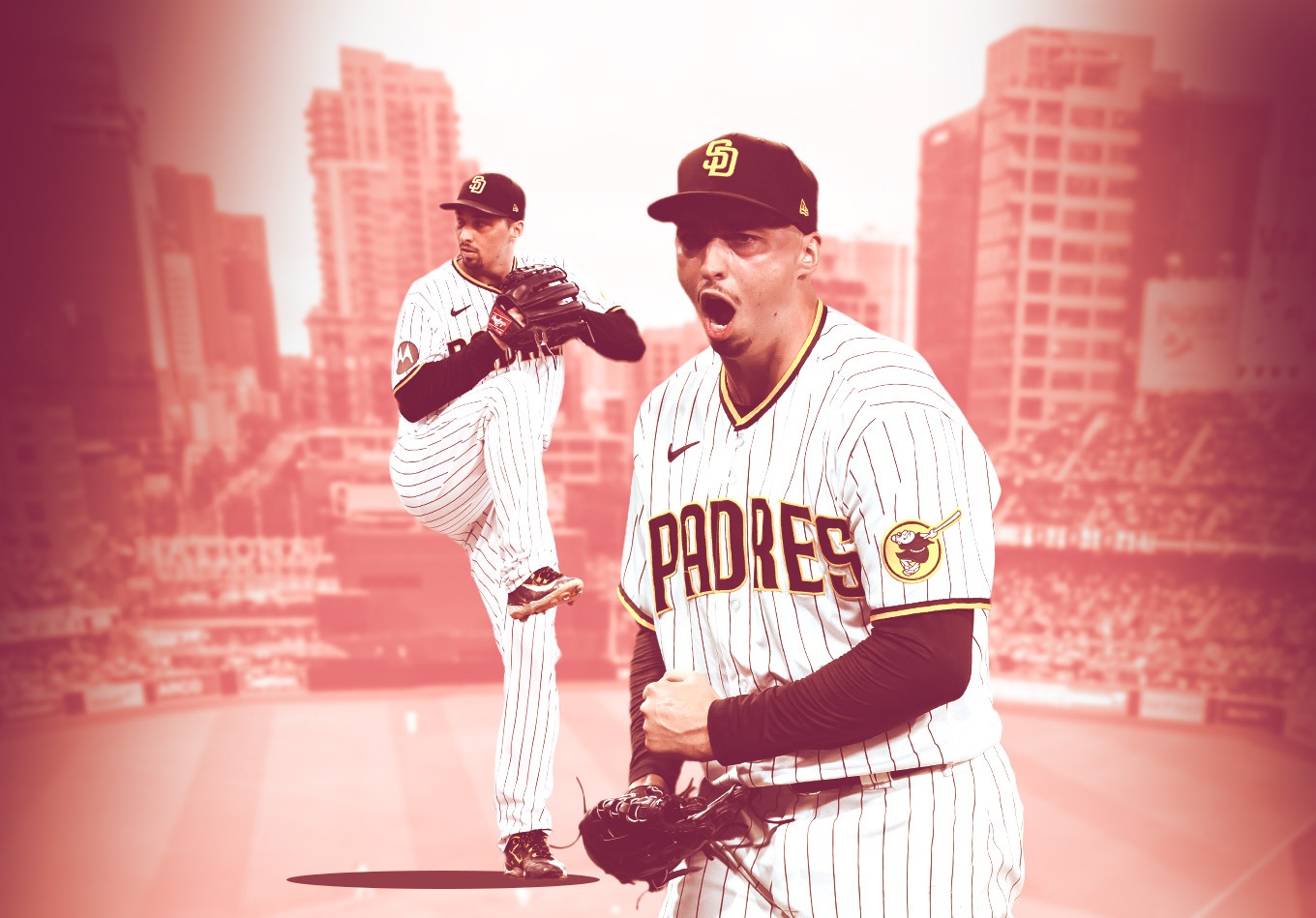Blake Snell, the reigning NL Cy Young winner, is the biggest MLB free agent left on the market.
And while the offseason has been slow as a whole, it’s not hard to imagine Snell’s asking price inspiring some disagreements as we move closer to spring training. The 31-year-old left-handed starting pitcher blends the brilliance of swing-and-miss stuff with the frequent frustration of missing the strike zone.
That boom or bust style shows up both in his season-by-season stats and in the aesthetic experience of watching him pitch. It also makes it more complicated to assess Snell’s contract long-term, and surely many MLB teams are coming up with less favorable figures than the top of his resume might suggest.
His potential for excellence isn’t a question, but the shape of his future production raises plenty of them, as this winter’s contract is almost certain to stretch into his mid or late 30s.
Snell has a couple calling cards, and a clear penchant for how he deploys them. In possession of a hard fastball and dynamite breaking stuff, he shows hitters the heater and dares them distinguish a high fastball from a curveball diving toward the dirt or a changeup riding the brakes.
The 95.4 mph average velocity on his four-seam is a real difference-maker from a southpaw. When he’s at his best, it helps maximize an approach that racks up strikeouts and skirts risky moments that might turn into homers by accepting an unusually high share of walks and the reality that he won’t be logging 200 innings.
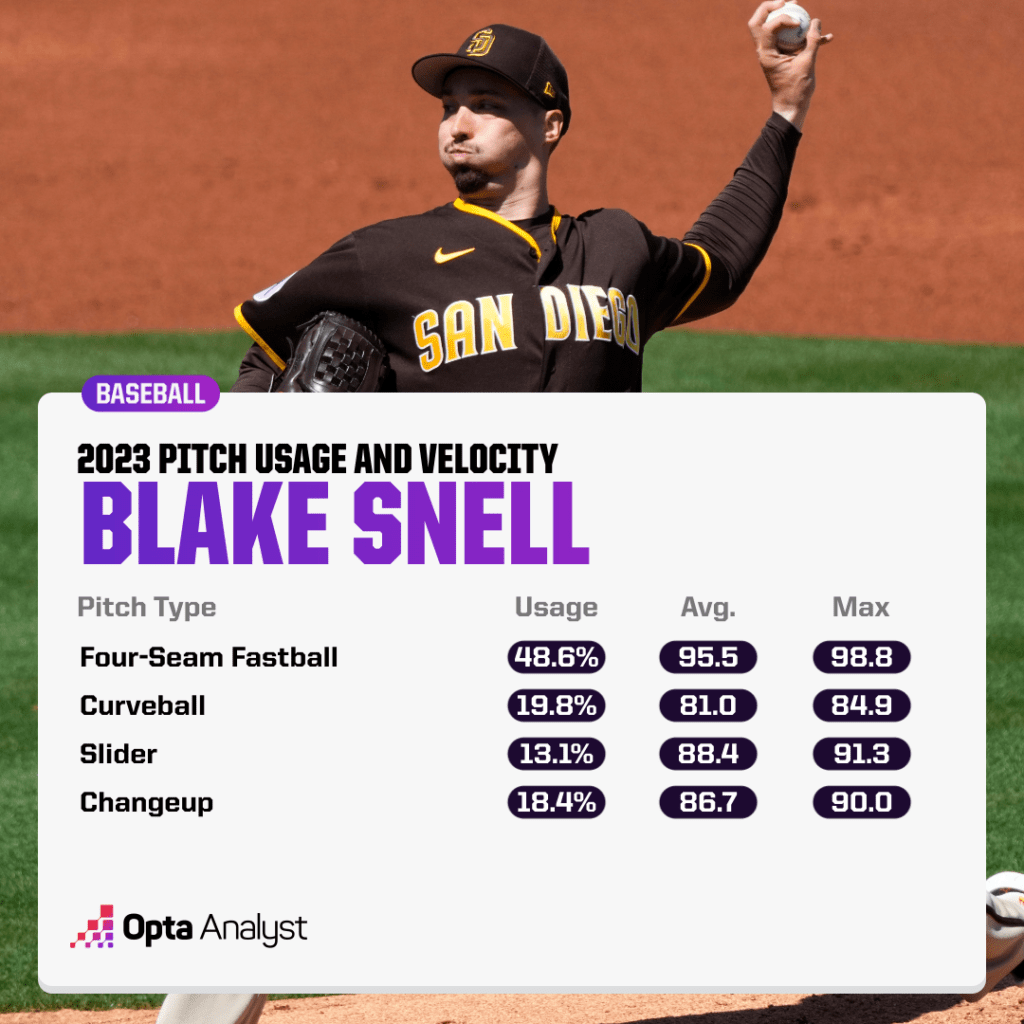
Snell’s 13.3% walk rate was the second-highest among starters with at least 120 innings in 2023, and his 99 total walks were the most in Major League Baseball, but that works out OK as long as his strikeout rate (31.5%) lives in elite territory.
Any team planning for Snell to front their rotation, though, has to account for the version of him that won’t have everything break quite as well as it did with the San Diego Padres last season.
No, for a performer as established as Snell, there are a lot of adjustments looming on the horizon. As he ages and experiences declines in velocity and possibly stuff quality, Snell will have to alter his approach in one way or another. The aging pitfall is a normal and unavoidable one for pitchers, but Snell has particularly wide error bars.
His undulating arsenal presents both worrisome challenges and hidden upside, if he finds ways to lean into his winning secondary pitches.
If Snell has a signature pitch, it’s probably his curveball – a true 12-to-6 yakker that takes a roller-coaster path to the plate, tunneling off his four-seamer while going more than 14 mph slower.
Would you believe, however, that the 2023 season was the first since 2019 in which it was Snell’s most-used secondary pitch? Each of his offspeed offerings – curve, slider and changeup – has taken a turn as the No. 2 option behind his fastball within the past four seasons.
At times, that inconsistency in usage mirrored some inconsistency in execution. In 2023, he used all of the options between 13% and 20% of the time. Arguably the biggest factor that vaulted Snell to another Cy-level peak was the synchronized success of his secondary stuff.
By whiff+, Snell was wielding two of the 20 best secondary weapons (min. 300 pitches) in MLB last season. His curveball, with a whiff+ of 183 (where 100 is the MLB average), was the single toughest breaking ball to touch among all starters.
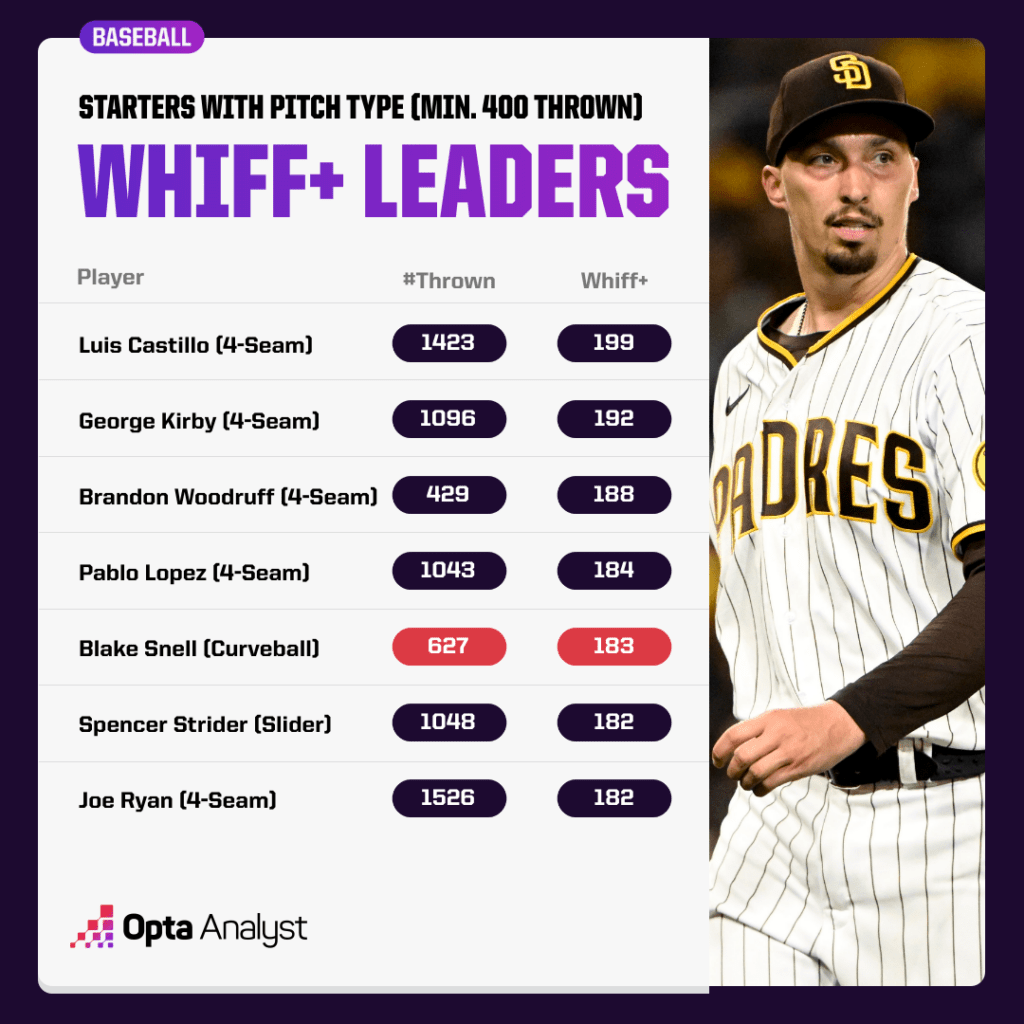
If you look at the results, the offspeed pitches stand out even more.
In 371 plate appearances that ended with one of Snell’s non-fastballs in 2023, the league batted an embarrassing .125/.208/.215 with 152 strikeouts and 34 walks, the second-best line any pitcher posted with his offspeed stuff (min. 1,000 pitches).
Here’s where that eye-popping success becomes a double-edged sword: His fastball results don’t look nearly as pretty. In the 325 plate appearances that ended on the four-seam, Snell allowed a .253/.392/.383 line with a nearly even ledger of 63 strikeouts and 59 walks.
As we know, Snell doesn’t throw many of his pitches in the zone, but it may be hard to conceptualize just how exceptional he is in treating the plate like lava. Traditionally, he’s had below-average command of his four-seamer and curveball, but above-average command of his slider and changeup.
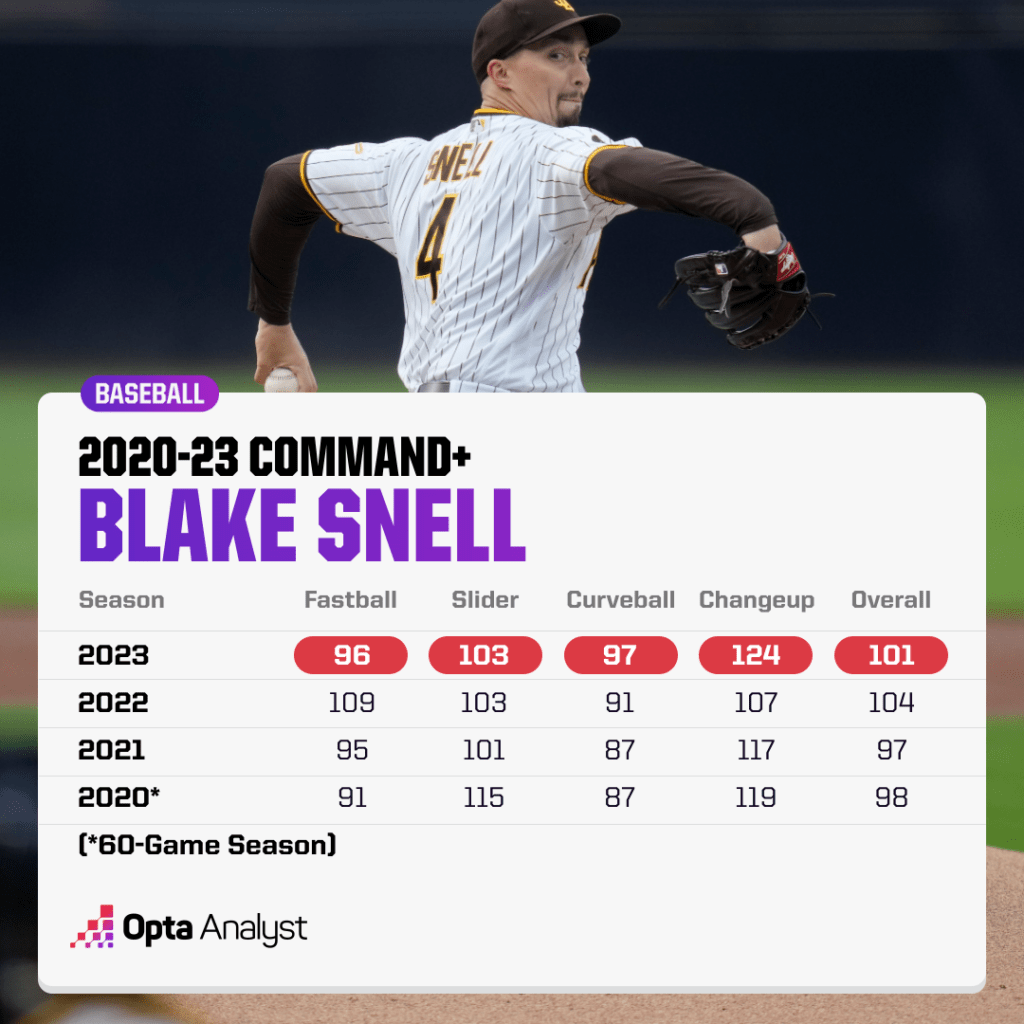
His 48.2% zone rate on the four-seamer was the fifth lowest among 170 pitchers who hurled at least 750 fastballs in 2023. His 31.8% zone rate on his offspeed pitches was the fourth lowest in the rankings among 129 pitchers who threw at least 750 of those.
Being that low on both lists is very strange. Take Kevin Gausman. The Toronto Blue Jays ace had the lowest zone rate on offspeed pitches in 2023, owing to his usage of the diving, visually deceptive splitter. To make that work, Gausman had the single highest fastball zone rate. That’s an extreme case, but it’s illustrative of the typical push and pull that pitchers use to make hitters work.
Using discipline+, we can see whether Snell is actually fooling hitters into making poor swing decisions. Do they take hittable strikes? Do they swing at balls in the dirt or out of reach? On his curveball and changeup, yes. He registered a 68 discipline+ on the curve (meaning 32% better than MLB average) and a 72 discipline+ on the curveball. But on the fastball, Snell logged a worse-than-average 108 discipline+.
Snell is fooling hitters much, much more often on the offspeed pitches, and getting better results on them, even as he dances far afield of the strike zone. As Esteban Rivera pointed out at FanGraphs last week using Statcast data, Snell has the lowest combined rate of breaking balls in the zone or in the “shadow zone” where he might most effectively pressure hitters to chase. And he owns that title by a lot. “He is the only pitcher on that list who throws his breaking balls in these two zones less than half the time,” Rivera wrote.
Obviously, given Snell’s appearance in New York to accept his National League Cy Young Award over the weekend, that extreme tact worked in 2023. (He also won the 2018 AL Cy Young Award with the Tampa Bay Rays.) It might be a mistake, however, to think it will continue to work.
There are a few ways it could happen, but it will almost certainly happen. The league will back Snell into a corner and force a change.
It might be a matter of his fastball losing a tick. Here’s how the league fared against left-handers throwing over 94 mph versus how they did against heaters just below that.
- Left-handed fastballs 94+ mph: .237/.327/.379
- Left-handed fastballs 91 to 93 mph: .276/.358/.460
It’s a pretty stark difference.
It might be a matter of losing consistent feel on one or more of his pitches for a few months or a season and needing a more robust fallback plan. We know he has tinkered with his offspeed usage before. Or it might be a matter of the league refusing to swing unless he puts a fastball in the zone. This is the nightmare scenario that Snell and his potential employers will be working to forestall.
Right now, Snell does not give up a particularly notable amount of damage on fastballs in the zone, but as the velocity split shows, there are small margins that could make big differences there.
Last season, he allowed a .455 slugging percentage on fastballs in the zone, but San Diego’s Petco Park is one of the friendliest for pitchers, and again, Snell was venturing into that territory relatively rarely. His reticence to throw strikes with the fastball ultimately drags down its value even when he’s not giving up loud contact.
By raw value, his four-seam fastball actually accumulated the second-worst total of any individual pitch in baseball. Now, what that mostly reflects is how much Snell threw the pitch. On a per-pitch basis, it was simply a mediocre pitch (below average in RV-), in league with fastballs from less ballyhooed pitchers such as Reid Detmers and Eric Lauer. Throw it more than 1,500 times, though, and it racks up a lot of bad outcomes.
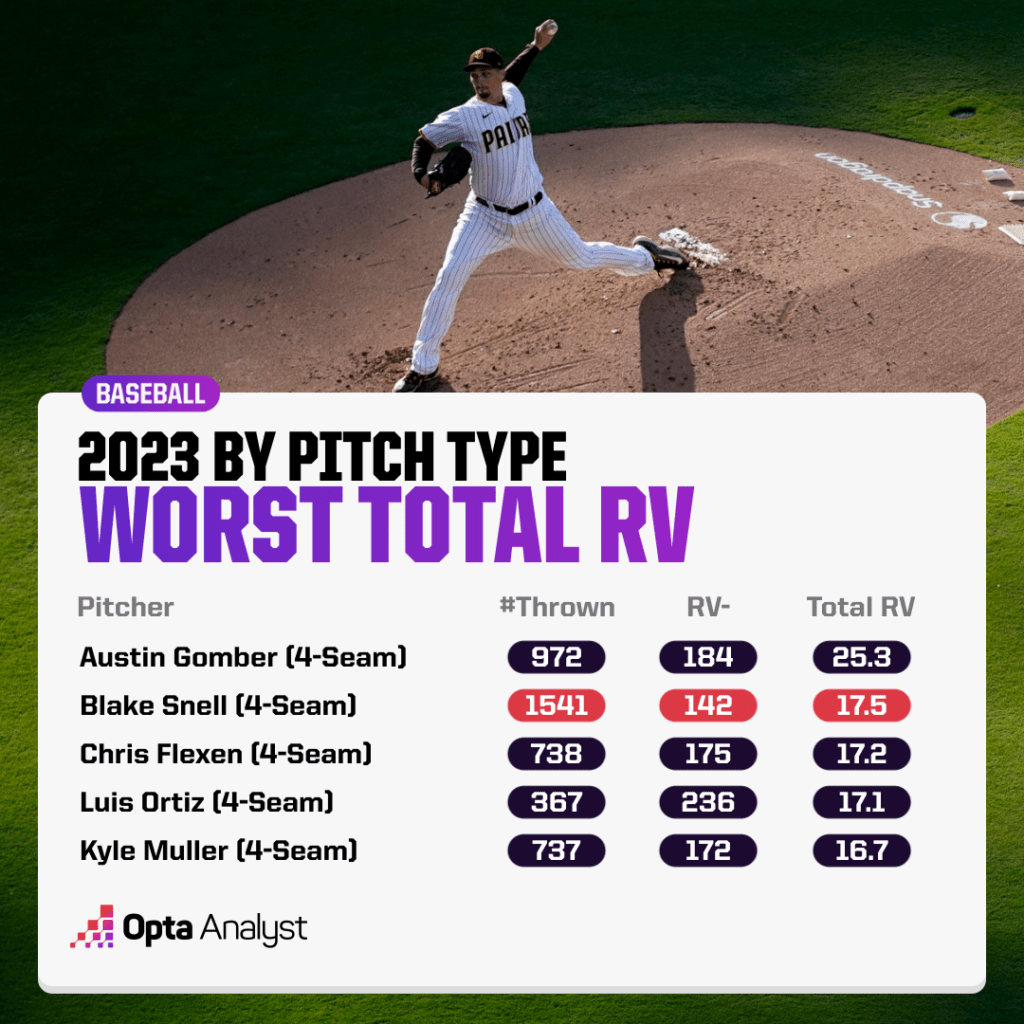
Teams formulating nine-figure contract offers for Snell in free agency will also be formulating plans to help him continue dominating even when one of these hurdles rears its ugly head. The team that ultimately tops the bidding will probably realize that Snell already has some solutions within reach.
Even though Snell hesitates (or simply struggles) to throw the offspeed pitches over the plate, he’s extremely successful when he does. Among the 129 pitchers who fired at least 750 offspeed offerings in 2023, only four induced lower wOBA marks from opposing batters on pitches in the strike zone. When Snell threw his secondary stuff in the zone, hitters limped to a .202 batting average with a .363 slugging percentage.
Pitchers with stuff – the hilariously vague term for the combo of movement and velocity – this dramatic can throw the ball right down Main Street and still get whiffs. Among starters, only Marlins rookie Eury Perez induced a higher percentage of whiffs on offspeed pitches in the zone.
So, one potential path for Snell is ramping up his usage of those pitches and cutting back on fastballs. That’s exactly what another (even more highly) decorated lefty has done in his 30s. Clayton Kershaw threw 60% fastballs before his age-30 season, and has used only 39.4% fastballs from that point forward, leaning more on his slider. Snell arguably has an easier path, as he has an excellent changeup, while Kershaw never truly developed one.
Snell is still using a fairly traditional pitch split. Last season he dipped under the 50% fastball threshold for only the second time, and just barely, at 48.6%. Only 24 pitchers (who fired at least 2,000 pitches) threw their primary fastballs more often than Snell, by percentage. He has plenty of room to adjust the dials.
There’s one other instructive path, and perhaps it’s the most interesting case study. Sonny Gray, the 34-year-old right-hander who signed with the St. Louis Cardinals earlier this winter, has also made a living dancing around the edges of the zone. His four-seam fastball allows similar results to Snell, but he throws it far less often.
And, notably, Gray is the only pitcher who earned better results on his offspeed pitches than Snell in 2023, by wOBA. He might provide a more ambitious model for how Snell might diversify his arsenal as he ages without necessarily altering his general approach to pitching.
Gray always had two variations on the fastball, a four-seam and a sinker. Typically, pitchers who can throw good changeups (as Snell can) are also capable of using sinkers, which have similar movement profiles. What Gray has done over the past few years, at ages Snell will soon be reaching, is more extreme. He has added a third breaking ball – his arsenal now includes sweeper, slider, curve – and last season he used a cutter to keep hitters off balance.
The cutter might be an especially attractive option for Snell, whose arsenal is limited against left-handed batters. He hasn’t thrown a changeup to a lefty since 2017. A fastball-like pitch that he feels comfortable throwing closer to the plate would be a boon against same-sided hitters, and couldn’t hurt as another option against right-handers.
Adding pitches isn’t an instant process or a guaranteed plan for success, but especially with increasing technology around pitch design, it’s a very attainable goal if Snell chooses to consider it. The first order of business for Snell’s future team will likely just be to discuss using his offspeed pitchers more often and closer to the plate. But the second order of business may well be to ask him about adding new arrows to his quiver.
Snell might not need to force a change immediately, but there’s real reason to be concerned that his game plan won’t continue to work unless he adds some new wrinkles. It’s part of why a Cy Young winner is still sitting on the market as February approaches, but it also might lead to a productive reinvention.
Check out our MLB and NBA coverage, and our NFL picks and college basketball predictions. Follow us on X and Instagram for more!
